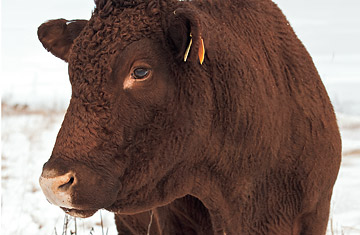
Cattle on this Hardwick, Mass., farm grow not on feedlots but in pastures, where their grazing helps keep carbon dioxide in the ground
(2 of 2)
From Vermont, where veal and dairy farmer Abe Collins is developing software designed to help farmers foster carbon-rich topsoil quickly, to Denmark, where Thomas Harttung's Aarstiderne farm grazes 150 head of cattle, a vanguard of small farmers are trying to get the word out about how much more eco-friendly they are than factory farming. "If you suspend a cow in the air with buckets of grain, then it's a bad guy," Harttung explains. "But if you put it where it belongs — on grass — that cow becomes not just carbon-neutral but carbon-negative." Collins goes even further. "With proper management, pastoralists, ranchers and farmers could achieve a 2% increase in soil-carbon levels on existing agricultural, grazing and desert lands over the next two decades," he estimates. Some researchers hypothesize that just a 1% increase (over, admittedly, vast acreages) could be enough to capture the total equivalent of the world's greenhouse-gas emissions.
This math works out in part because farmers like Shinn don't use fertilizers or pesticides to maintain their pastures and need no energy to produce what their animals eat other than what they get free from the sun. Furthermore, pasturing frequently uses land that would otherwise be unproductive. "I'd like to see someone try to raise soybeans here," he says, gesturing toward the rocky, sloping fields around him.
By many standards, pastured beef is healthier. That's certainly the case for the animals involved; grass feeding obviates the antibiotics that feedlots are forced to administer in order to prevent the acidosis that occurs when cows are fed grain. But it also appears to be true for people who eat cows. Compared with conventional beef, grass-fed is lower in saturated fat and higher in omega-3s, the heart-healthy fatty acids found in salmon.
But not everyone is sold on its superiority. In addition to citing grass-fed meat's higher price tag — Shinn's ground beef ends up retailing for about $7 a pound, more than twice the price of conventional beef — feedlot producers say that only through their economies of scale can the industry produce enough meat to satisfy demand, especially for a growing population. These critics note that because grass is less caloric than grain, it takes two to three years to get a pastured cow to slaughter weight, whereas a feedlot animal requires only 14 months. "Not only does it take fewer animals on a feedlot to produce the same amount of meat," says Tamara Thies, chief environmental counsel for the National Cattlemen's Beef Association (which contests the U.N.'s 18% figure), "but because they grow so quickly, they have less chance to produce greenhouse gases."
To Allan Savory, the economies-of-scale mentality ignores the role that grass-fed herbivores can play in fighting climate change. A former wildlife conservationist in Zimbabwe, Savory once blamed overgrazing for desertification. "I was prepared to shoot every bloody rancher in the country," he recalls. But through rotational grazing of large herds of ruminants, he found he could reverse land degradation, turning dead soil into thriving grassland.
Like him, Coleman now scoffs at the environmentalist vogue for vilifying meat eating. "The idea that giving up meat is the solution for the world's ills is ridiculous," he says at his Maine farm. "A vegetarian eating tofu made in a factory from soybeans grown in Brazil is responsible for a lot more CO2 than I am." A lifetime raising vegetables year-round has taught him to value the elegance of natural systems. Once he and Damrosch have brought in their livestock, they'll "be able to use the manure to feed the plants, and the plant waste to feed the animals," he says. "And even though we can't eat the grass, we'll be turning it into something we can."
